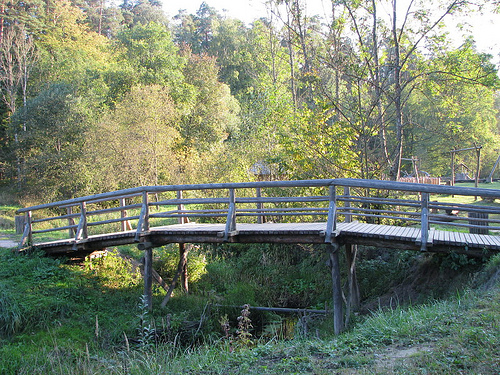
Location: 75 km (47 mi) South of Riga
Info: pagasta eka, 6376 3472
Anna Brigadere Museum
Spridisi Tel. 2653 2691
Open: May- Oct: 10am- 5pm Wed- Sun
Tervete History Museum
Jerumi
Tel. 2989 6804
Open: May- Sep: 10am- 5pm Tue- Sun

Tervete Nature Park is situated 75 km (47 mi) South of Riga in Latvia. It only takes about one hour to get from the Latvian capital. The paths are well marked and easy to follow. Most of the Tervete Nature Park lies in the pine forests. Some of the trees are over 300 years old. Additionally to clean and healthy air the forest might be interesting to the kids. The natural park contains several playgrounds with fairly tale houses and sculptures. Additionally you can find historic medieval ruins of the Dobele Castle as well as ancient castle mounds. Another popular destination in the Tervete Nature park is a Swans Lake. Boats are available for rent if you feel like exploring the quiet banks of the lake. Additionally you can spend the whole day fishing, bird watching or swimming. Most of the tourists try to make here during Zemgalians Festival and Craftsmen Fair that are held here annually.
The first tree plantings were made in
Kalnmuiža park. Dendrological plantings in Tērvete "Sprīdīši" owned
by Anna Brigadere were started in 1931. In 1932, the Tērvete
tuberculosis sanatorium was built in the style of functionalism
(architect A. Klinklāvs, reliefs of K. Zemdega). In 1935, 523 trees
and shrubs belonging to 467 species and varieties were planted near
Sprīdīši. In 1945, the resort forests of Tērvete were included in
the list of Group I forests, which included forests - natural
monuments and forests of suburban green areas. In 1957, the Tērvete
forest massif called Kalnamuižas sils (total area 960 ha) was one of
the largest nature protection objects in Latvia.
In 1963, the
Ministry of Forestry and Forest Industry of the Latvian SSR granted
funding for the establishment of the Tērvete Forest Landscape Park.
The improvement works of the park took place under the leadership of
Miķelis Kļaviņš (1958–1973), the deputy forester of Tērvete
forestry, who created the following components of the landscape
park:
Solar mood park with Iršu Garden, Holy (Swedish) Hill,
Tērvete Castle Mound, Tērvete Parish Building and Anna Brigadere
Museum "Sprīdīši";
Old pine park with more than 100 years old
pines;
Fairytale forest with wooden sculptures by Krišjānis
Kugras;
Landscapes of Pļavnieki, Silalībietis and Auziņi;
Tērvete sanatorium new park and Kalnamuiža old park;
Chester
Forest behind Tērvete Lutheran Church;
Mežavoti forest in the
vicinity of Melno mill or behind the Black Pub.
On his
initiative, a project of Zemgale National Park was developed in
1969, which, however, was not implemented. In 1975, the nature park
came under the control of Dobele forestry, and from 1988 as part of
Tērvete forestry. The 1999 Regulations of the Cabinet of Ministers
of Latvia “On Nature Parks” approved the nature park “Tērvete” as a
protected territory. From 2000, the management of the nature park
was taken over by the Zemgale Forestry Recreation and Hunting
Division, and from 2004 - the “Recreation and Hunting” Park
Division.
In 2005, the nature park “Tērvete” was included in
the European network of specially protected nature territories
Natura 2000. A Tourism Information Center was established in the
park, which provides information about the nature park “Tērvete” and
other tourism objects of Tērvete region. Trained guides accompany
groups of tourists in the nature park. The association "Tērvete
Development Association" operates in the nature park.
Functional zoning
According to the Nature Park's Individual
Protection and Use Regulations 2008 (No. 513), it has the following
functional areas:
Nature reserve zone for the protection of
specially protected forest habitats, biologically valuable old
forests, rare and specially protected species and their habitats;
Nature park area to preserve the characteristic ecosystems, cultural
and historical environment and landscape, as well as recreational
resources;
Neutral zone to promote the development and
sustainable economic use of the territory.
The largest areas are occupied by boreal forests (naturally old pine forests), which are especially important for the preservation of biodiversity and the characteristic landscape of the nature park. The protected area represents 11 specially protected habitats in Latvia and 9 in Europe: boreal forests - 117.7 ha, mixed broad-leaved forests - 22.0 ha, slope and ravine forests - 3.11 ha, a complex consisting of wet broad-leaved forests and mineral-rich springs and spring bogs - 36.3 ha, black alder sedges - 0.3 ha, dry meadows in calcareous soils - 11.6 ha, moderately moist meadows - 11.7 ha and plain to mountain level watercourses with Ranunculion fluitantis and Callitricho-Batrachion vegetation - 3.5 ha.